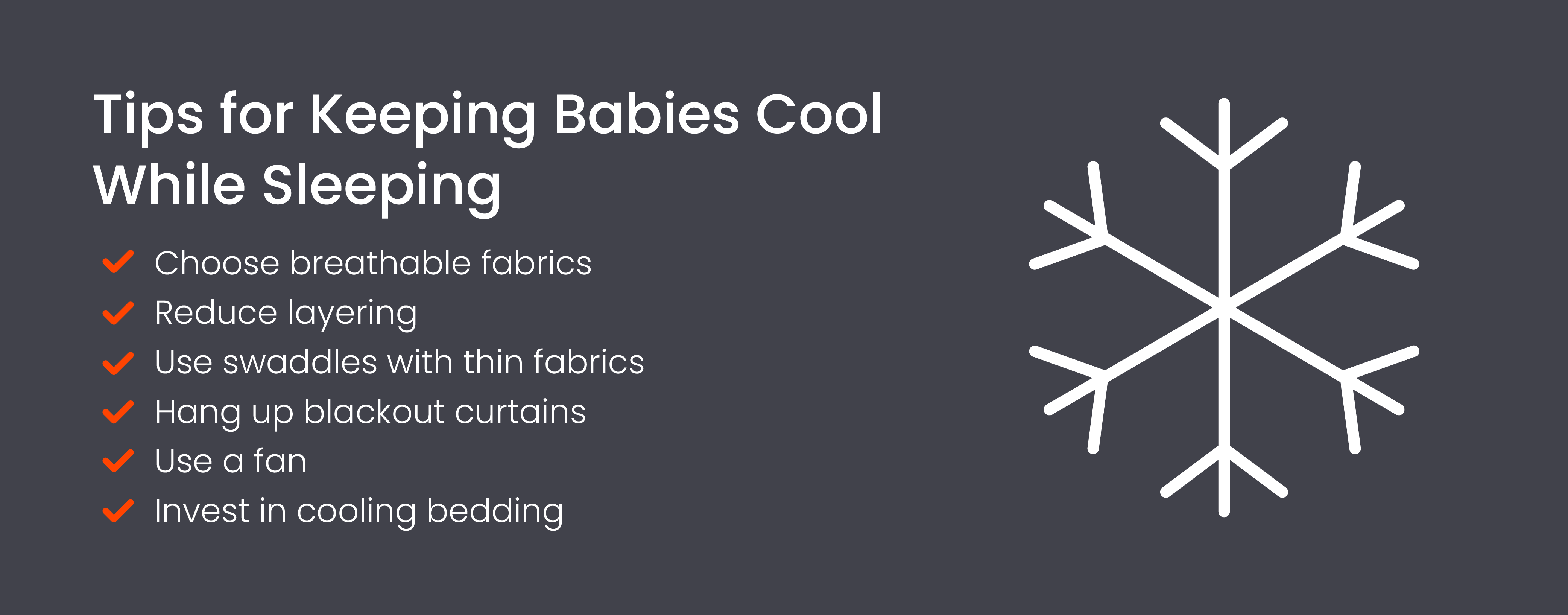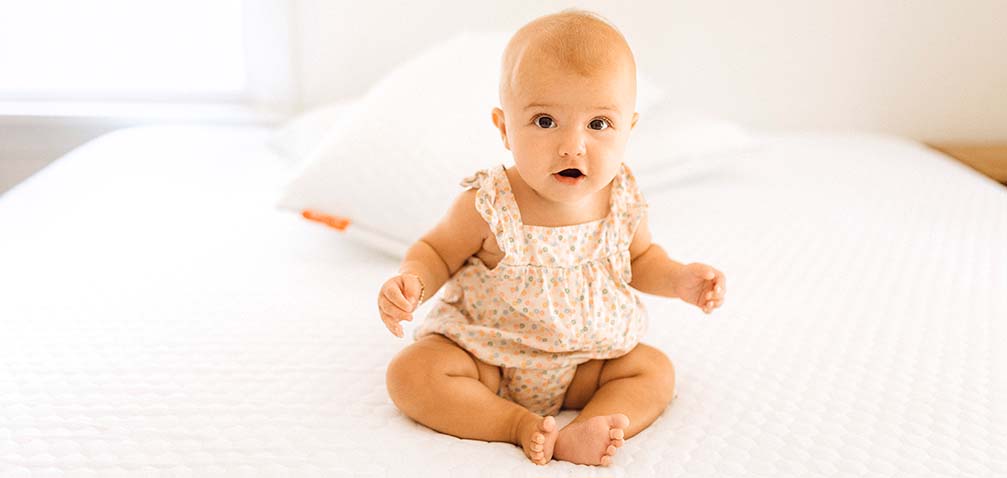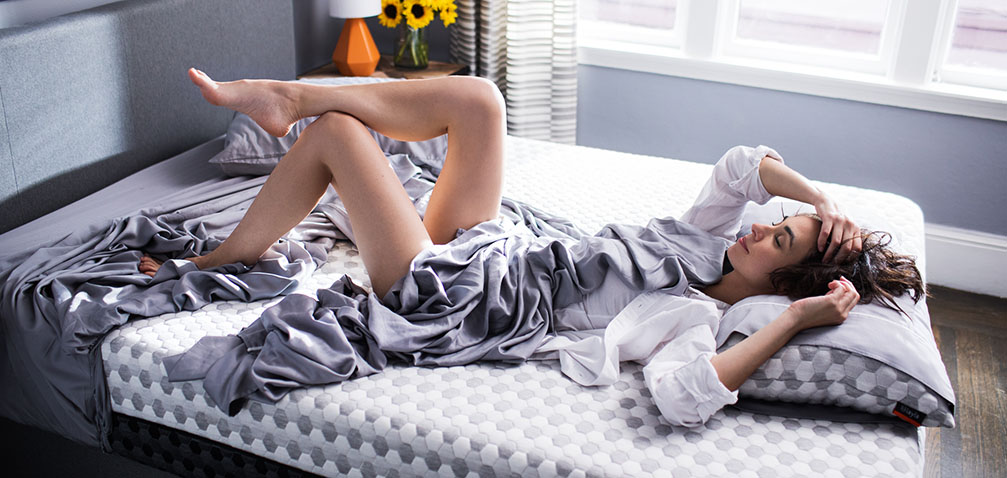- The Importance of Keeping Your Baby From Overheating During the Night
- Tips for Keeping Your Baby From Getting Too Hot While Asleep
- Keeping Your Baby Cool with Layla Sleep
The Importance of Keeping Your Baby From Overheating During the Night
It’s common for parents to worry about whether their baby will get too hot sleeping at night. Babies are more prone to overheating because they can’t regulate their body temperatures. Keeping your baby cool throughout the night can help improve their sleep quality and prevent:
Skin rashes
Heat exposure can lead to skin rashes and irritation in infants. Babies may sweat, overheat, or become dehydrated, causing rashes or skin conditions like dry skin. Keeping your baby hydrated and removing layers on hot nights can prevent skin rashes due to moisture on their skin.
Discomfort
Just like you, when babies are too warm, they can become uncomfortable, making it difficult for them to sleep. Discomfort and crankiness will lead to crying throughout the night, but you can prevent it by keeping your baby cool by dressing them appropriately for the indoor temperature.
Dehydration
Continuous exposure to heat can lead to dehydration in infants, reducing the water content in their bodies. While dehydration is more common when your baby is outside, it can happen when the rooms where they sleep become too warm. You can prevent dehydration by keeping them hydrated all day long, ensuring they drink water before bed, and feeding them throughout the night.
Heat stroke
Babies don’t sweat as much as children and adults, which means it’s more difficult for them to regulate their body temperatures and cool off naturally. Therefore, babies are more prone to heat stroke than older kids and adults. Heat stroke results in rising body temperatures, hot skin, difficulty breathing, and confusion. If your child is experiencing heat stroke, it’s important to try to cool them down as soon as possible and take them to the doctor for advice.
SIDS
Sudden Infant Death Syndrome (SIDS) can be brought on by extreme temperatures, including hot and cold temperatures. Multiple layers and warm room temperatures may increase the risk of SIDs, and infants in danger may feel hot to the touch, as though they are overheating.

Of course, you can reduce this risk by removing layers before bed and keeping your child’s room cool. The ideal room temperature for babies is 68 to 72 degrees, but it may not always be possible to measure the temperature of a single room in your home. Some rooms can be much warmer or cooler than others.
Tips for Keeping Your Baby From Getting Too Hot While Asleep
Now that you understand the importance of keeping your baby from getting too hot while they sleep, you must find ways to keep them cool. There are many ways to keep your baby cool, including turning the air conditioning on at night, using fans, and wearing quality summer clothing for infants. You can tell if your baby is too warm at night if they’re unable to sleep or feel moist to the touch.
Remember, if a bedroom is too warm for you to sleep in, it is much too warm for your infant since they can’t regulate their own body temperatures. Here are some tips to help keep your baby cool in the summer:

Opt for breathable fabrics
What should a baby wear to sleep? Consider lightweight fabrics if you’re wondering how to dress a newborn in the summer. If it’s over 70 degrees in the baby’s room, they should only wear light clothing and no layers, including light short-sleeved bodysuits and swaddles. Always opt for breathable fabrics when shopping for summer bedding for babies, clothes, blankets, and more.
Breathable fabrics allow your hot air to escape the material, whether it’s a onesie or bedding, rather than trapping it between the baby’s body and the material. Summer pajamas for babies should be made of breathable fabrics, including:

- Cotton: Cotton is one of the most common fabrics for babies because it’s affordable and soft on the skin. It’s also available in various forms, including clothing and bedding. Cotton is soft, breathable, and durable. It’s also easy to care for, allowing you to toss soiled clothing or sheets directly into the wash.
- Bamboo: Bamboo is one of the most sustainable fabrics and makes a great choice for infants because it’s breathable and moisture-wicking. Not only will hot air escape the blanket to keep your baby cool, but bamboo wicks moisture off their skin, allowing it to evaporate on the blanket instead. Bamboo is also durable and doesn’t easily absorb moisture, making it a great option for babies who tend to have accidents at night.
- Rayon: Rayon is made from wood pulp and is available in various fabrics with different characteristics. This fabric has a silky feel and offers breathability for those in warm climates but isn’t ideal for those in hot climates with indoor temperatures above 70 degrees. Unfortunately, rayon does not wick away moisture as well as other materials, and some require dry cleaning, which isn’t ideal when you have a toddler who soils clothing frequently.
- Polyester: Polyester is another popular material because it’s affordable and wicks away moisture while drying quickly. It also resists pilling, so it won’t get scratchy after frequent washing. Unfortunately, polyester isn’t always breathable, as this feature depends on the knit or weave type.
- Nylon: Nylon is a synthetic material that’s durable and versatile. It’s much stronger than cotton and offers significant stretch. It’s also cool and smooth to the touch and offers ultimate breathability.
- Linen: Linen fabric is a popular choice for summer clothing and bedding because it’s breathable and durable. The fibers in linen are large, and blankets and clothing have more open weaves to allow better airflow. Unfortunately, linen doesn’t wick away moisture and can be scratchy on delicate infant skin.
Reduce your layering
Try to reduce layering in the summer, especially in warm rooms where your child sleeps. You can dress them in a single onesie that will keep their arms and legs cool. You can use layers to adjust their temperature, depending on the internal temperature of your home. Never dress your child for sleep based on the temperature outside, because it could make them too warm or too cool, depending on the season.
If you must swaddle, opt for thin fabrics
You should avoid loose bedding with infants because it can be a suffocation risk. Your young one can sleep without a blanket if it’s warm enough in your home, but if you must swaddle, always use thin fabrics. There are many swaddles on the market that cater to your individual needs. For example, you can find some with special fabrics designed to help regulate your baby’s temperature by absorbing heat. Since swaddling is recommended until your child can roll over on their own (around three or four months), you must always opt for summer-friendly fabrics.
Use blackout curtains
Blackout curtains prevent the sun from entering your baby’s room, allowing it to stay cool since the sun can heat rooms even though the thermostat is set to a particular temperature. In addition, blackout curtains will ensure your child’s room stays cool all day long, making it easier to cool down at night when they’re ready for sleep.
Use a fan
Using a fan is a great way to create a cross breeze in your baby’s room to lower the temperature. Fans also offer better ventilation in the room by circulating the air and improving airflow. But, of course, keep the fan away from your baby’s crib and don’t point it directly at them because it can cause them to get cold instead of staying perfectly cool.
Use cooling bed sheets and bedding
Cooling sheets and bedding are designed with cooling and breathable fabrics that keep your infant’s crib cool while they sleep. With fabrics like cotton and bamboo, they improve air circulation throughout the crib, including through the mattress itself, to ensure your child’s body temperature is perfectly regulated. Cooling bamboo sheets, in particular, are ideal for hot summer nights because they wick away sweat and moisture while allowing airflow between the sheets and your child’s body.

Wondering how to dress your baby for sleep in the winter? Opt for warmer clothes and bedding that trap their body heat to regulate their temperature and keep them warm at night.
Keeping Your Baby Cool with Layla Sleep
Keeping your baby cool during the hot summer is crucial for their health and wellness. With these tips, you can keep your baby cool and ensure they have a good night’s sleep, something that’s good for everyone. Consider cooling blankets, mattresses, and bedding from Layla Sleep when trying to keep your baby cool while they sleep. Our summer bedding allows for ultimate breathability to keep your child comfortable throughout the night. Of course, you should also follow our hot-sleeper tips to ensure your baby gets a quality night’s sleep in the summer.



